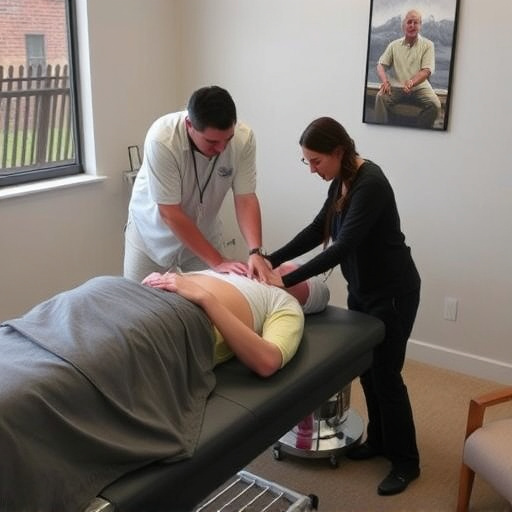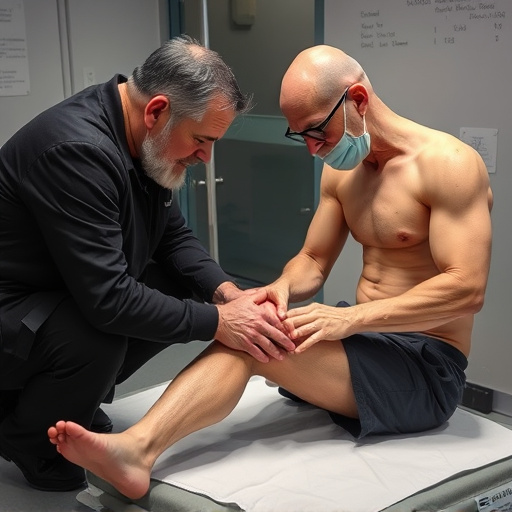Shockwave tendonitis relief utilizes high-energy sound waves to stimulate healing in damaged tendons, offering a non-invasive alternative to surgery for overuse or minor injury-induced tendinitis. This method provides joint pain relief and accelerates natural healing, enhancing recovery after accidents and potentially preventing future surgeries. While initial studies show promising long-term symptom alleviation, recovery varies among individuals, and permanent relief is not guaranteed.
“Discover how shockwave tendonitis relief could be your key to avoiding surgery. This non-invasive method is gaining traction in medical circles as a potent treatment for tendon inflammation. By understanding the techniques behind shockwave therapy and its potential benefits, you’ll explore how it can prevent surgical interventions, offering a promising alternative for long-term pain management. Uncover the recovery process and whether this innovative approach provides lasting relief from tendonitis.”
- Understanding Shockwave Tendonitis Relief Techniques
- Potential Benefits: Preventing Surgery with Non-Invasive Methods
- Long-Term Effects and Recovery: Can It Last?
Understanding Shockwave Tendonitis Relief Techniques

Shockwave tendonitis relief techniques have gained prominence as a non-invasive approach to managing this common condition. This method utilizes high-energy sound waves, known as shockwaves, to stimulate healing in damaged tendons. By targeting specific areas of pain and inflammation, shockwave therapy for pain can provide significant joint pain relief and accelerate the body’s natural healing process.
These techniques are often sought after as an alternative to surgery, especially in cases where tendinitis is caused by overuse or minor injuries. Post accident rehabilitation may incorporate shockwave therapy as a way to enhance recovery and prevent future surgeries. The non-invasive nature of this treatment makes it appealing for those looking to avoid surgical procedures, while still aiming for effective shockwave tendonitis relief.
Potential Benefits: Preventing Surgery with Non-Invasive Methods

Potential Benefits: Preventing Surgery with Non-Invasive Methods
One of the significant advantages of shockwave tendonitis relief is its potential to prevent surgery later on. Tendonitis, an inflammation of tendons, can lead to chronic pain and reduced mobility if left untreated. Traditional treatments like rest, physical therapy, and medication often provide temporary relief but may not address the underlying structural issues. Shockwave therapy, however, uses acoustic waves to stimulate tissue repair and promote natural healing processes, offering a non-invasive approach that can significantly alleviate symptoms and potentially reverse damage.
This method is particularly beneficial for individuals seeking to avoid surgical procedures like spinal adjustment or whiplash treatment, which carry their own risks and recovery times. By opting for shockwave tendonitis relief, patients can take a proactive step towards maintaining joint health and mobility without the invasiveness of surgery. Moreover, non-invasive methods like this one are often more cost-effective and convenient, making them attractive alternatives for those looking to prevent surgical interventions.
Long-Term Effects and Recovery: Can It Last?

Shockwave tendonitis relief offers a promising non-invasive approach to managing chronic tendon inflammation, potentially reducing the need for surgical interventions. While initial studies suggest long-term efficacy in alleviating symptoms and improving function, it’s essential to understand that recovery from shockwave therapy varies among individuals. Some patients experience sustained neck pain relief, even preventing herniated disc surgery or neck pain treatment options. However, others may find symptom relief temporary, requiring repeated treatments or alternative approaches.
The durability of shockwave tendonitis relief depends on several factors, including the severity of the initial condition, adherence to post-treatment care protocols, and individual patient response. Research indicates that for many patients, positive outcomes can last for months or even years, significantly decreasing the likelihood of future surgeries. Yet, it’s crucial to manage expectations, as there’s no guarantee of permanent relief.
Shockwave tendonitis relief offers a promising non-invasive approach to managing this condition, potentially preventing the need for surgery. By utilizing advanced technology, these techniques can provide significant benefits in terms of pain reduction and improved mobility. While individual results may vary, many patients report lasting relief, indicating its potential as a long-term solution. However, further research is needed to fully understand the extent of its effects. Incorporating shockwave tendonitis relief into treatment plans could be a game-changer, allowing individuals to avoid surgical interventions and embrace a more active lifestyle.














